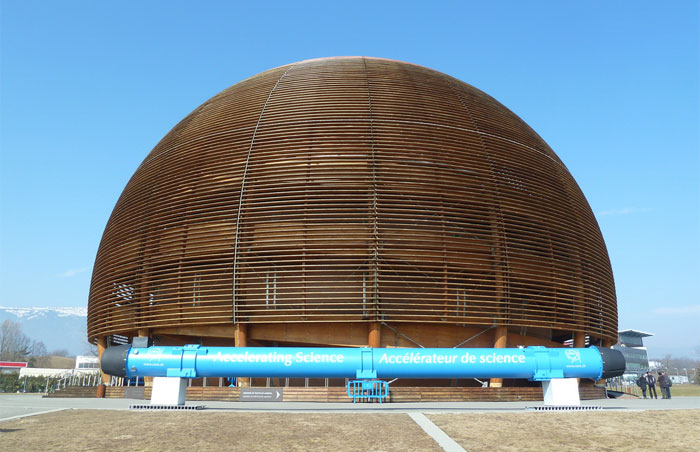CERN
FEBRUARY 27, 2012
On Saturday I went to CERN. It was
amazing.

The first thing you need to know
about CERN is that it’s a misnomer. The N stands for
Nuclear which sounded cool in 1954 but they’ve
actually worked on sub-nuclear
stuff ever since then.
And the second thing that is
connected to the first thing is that all the numbers
are really, really big or really, really small.
Really, really, really. CERN is one of those things
I thought I understood but hadn’t actually thought
about too hard and when I did think about it I got
high on Science. The principle of the whole thing is
actually quite simple but achieving it is the most
massive extraordinary physics and engineering and
computing project we as a species have ever
attempted. It is the best thing.
CERN—and specifically the Large
Hadron Collider—is an attempt to simultaneously
create the hottest place in the Universe and the
near-coldest place in the Universe, on Earth, just
outside Geneva, and millimetres away from each
other. (The former, the conditions of the Big Bang;
the latter, the 1.5° Kelvin of deep vacuum space and
superconducting magnets cooled with liquid helium.
The core beam tubes of the LHC are colder and
emptier than most of space.)
You know, maybe aliens know all this,
and we’re come-latelies to the whole
comprehending-everything thing,
but there isn’t really any more you can do in our
current Universe than this. It’s the top thing. It
is everything.
This makes us amazing.
Before going, I was all blasé and
geeky, and all “the LHC is great but I really want
to see Room 404 and the first web server.” By the
end of the tour I had completely forgotten about
this, and only checked at the last minute to find that
NeXT box in
a little cabinet half-hidden in a massive gallery of
particle stuff. Because, you know the web is cool
and all, but when you’re trying to understand the
fundamental building blocks of the universe and
constructing the single greatest scientific
instrument of ours and perhaps any civilisation, the
whole modern internet is a happy side effect, it is
a nice
to have.
Here’s a thing. They study all sorts
of particles at CERN in ways I won’t go into, but
one that bears mentioning is neutrinos. Well, they
produce the neutrinos as a byproduct of various very
small, very fast things at CERN but they study them
at Gran Sasso in Italy, in a specially-constructed
chamber 1400m below a mountain, because that is how
you hide from cosmic
rays. And Gran Sasso is 730 km from CERN, but
because neutrinos are very, very small and will pass
straight through anything, they don’t need to build
a pipe or a tunnel they just fire them through
the crust of the earth itself.
Here’s another thing. Magnets are a
big deal at CERN, because you need them to steer the
beams of very, very fast particles around in a big
circle. And the French word for magnets is
“aimants”, which means “loving”. The LHC is a
massive loving machine, and I love the Académie
française.
They’ve been building particle
accelerators at CERN for 50 years and they’re still
using all the existing ones, and what’s more they
use them all together. So it starts with a tank of
hydrogen and it goes into a little old linear
accelerator and then it goes into a slightly larger,
slightly newer cyclical accelerator and then a
larger, newer one and so on until it is injected
into the LHC as very fast clumps of protons and sped
up even more until BOOM and you hope just maybe you
might see a Higg’s Boson, which even if it exists
you might only see a couple a day and even then you
might not see it because there are a millions of
possible boring interactions at the same time. And
maybe it doesn’t exist and that means we’re all
wrong and that is brilliant too because then we know
we have to figure something else out.
When they designed the LHC they
thought they’d have about 15 petabytes of data per
year to analyse. In the second year of operation,
they generated 50 petabytes. Experiments are good
when they are bounded by things like the speed of
light and the age of the observable universe.

You can’t go down into the tunnels
since the LHC started operating, so we only went to
a couple of test facilities and one of the control
rooms but it didn’t matter at all. We had an amazing
guide who was a physicist who used to work on
software and stuff (formerly Fortran, now C++) and
who wore a beret and had a brilliant Eastern
European accent and must have spent so many
depressing hours with gangs of bored schoolkids but
when he realised we were genuinely interested just
opened up and answered all of the questions, even
the stupid ones. (It didn’t hurt that one of us was a
guy who built a working fusion reactor in his
basement in Brooklyn. Knowing the right
questions helps.)
I am slightly ashamed that I didn’t
get it before but I get it now and I am humbled and
amazed and still sort of dazed.
Thanks to Lift and
particularly to Nicholas
Nova for
organising trip. If you ever get the chance to go,
go go go.
Photos at Flickr.
Source: Booktwo.org
|


